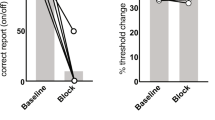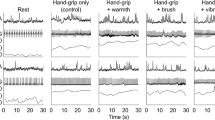Abstract
Painful and non-painful pressure sensations from muscle are generally accepted to exist but the peripheral neural correlate has not been clarified. The aim of the present human study was to assess the non-painful and painful pressure sensitivity with (1) anaesthetised skin, and (2) anaesthetised skin combined with a block of large diameter muscle afferents. The skin was anaesthetised by a topically applied anaesthetic cream and later lidocaine was administrated subcutaneously. The pressure sensitivity was assessed quantitatively by computer-controlled pressure stimulation on the anterior tibial muscle. Thresholds to detection, pain and pain tolerance were assessed. In the first experiment, computer-controlled needle insertion depths evoking touch and pain sensations were used to assess the efficacy of cutaneous anaesthesia. Touch and pain sensations evoked during needle insertions were found to be superficial in intact skin but when anaesthetised, touch sensation was occasionally evoked at depths related to penetration of the fascia. With the skin completely anaesthetised to brush and von Frey hair pinprick stimulation, skin indentation with the strongest von Frey hair caused a sensation described as a deep touch sensation. Simultaneously, pressure detection and pain thresholds increased but it was still possible to elicit non-painful and painful pressure sensation in all subjects. In a second experiment, a differential nerve block of group I and II afferent fibres was obtained by full-leg ischaemia simultaneously with cutaneous anaesthesia. The efficacy of the tourniquet block was continuously assessed by a battery of somatosensory tests (heat, brush, vibration, electrical and movement detection) applied at the foot simultaneously with pressure stimulation on the anterior tibial muscle. After 20 min of ischaemia, group II afferent fibres mediating the sensations of movement detection, vibration and brush on the foot was blocked but the heat pain threshold was not affected. In this condition (anaesthetised skin and block of group I and II fibres from deep tissue) a pressure sensation was evoked in 70% of subjects although the pressure detection threshold was increased. The pressure pain sensitivity was decreased, which, however, might indicate a partial block of group III and IV muscle afferents. In a third experiment, the tactile sensations elicited by electrical stimulation of the tibialis anterior muscle and skin at the lower leg were significantly decreased after 20 min of ischaemia, validating the blocking effects of group I and II nerve fibres. The present data show a marginal contribution of cutaneous afferents to the pressure pain sensation that, however, is relatively more dependent on contributions from deep tissue group III and IV afferents. Moreover, a pressure sensation can be elicited from deep tissue probably mediated by group III and IV afferents involving low-threshold mechanoreceptors.






Similar content being viewed by others
References
Abrahams VC (1986) Group III and IV receptors of skeletal muscle. Can J Physiol Pharmacol 64:509–514
Arendt-Nielsen L, Bjerring P (1988) Laser-induced pain for evaluation of local analgesia: a comparison of topical application (EMLA) and local injection (lidocaine). Anesth Analg 67:115–123
Arendt-Nielsen L, Bjerring P (1989) The effect of topically applied anaesthetics (EMLA cream) on thresholds to thermode and argon laser stimulation. Acta Anaesthesiol Scand 33:469–473
Arendt-Nielsen L, Bjerring P, Nielsen J (1990) Regional variations in analgesic efficacy of EMLA cream. Quantitatively evaluated by argon laser stimulation. Acta Derm Venereol 70:314–318
Bjerring P, Arendt-Nielsen L (1990) Depth and duration of skin analgesia to needle insertion after topical application of EMLA cream. Br J Anaesth 64:173–177
Bromm B, Treede RD (1984) Nerve fibre discharges, cerebral potentials and sensations induced by CO2 laser stimulation. Hum Neurobiol 3:33–40
Burke D, Mackenzie RA, Skuse NF, Lethlean AK (1975) Cutaneous afferent activity in median and radial nerve fascicles: a microelectrode study. J Neurol Neurosurg Psychiatry 38:855–864
Diehl B, Hoheisel U, Mense S (1993) The influence of mechanical stimuli and of acetylsalicylic acid on the discharges of slowly conducting afferent units from normal and inflamed muscle in the rat. Exp Brain Res 92:431–440
Egekvist H, Bjerring P, Arendt-Nielsen L (1999) Regional variations in pain to controlled mechanical skin traumas from automatic needle insertions and relations to ultrasonography. Skin Res Technol 5:247–254
Estersohn HS, Sourifman HA (1982) The minimum effective midthigh tourniquet pressure. J Foot Surg 21:281–284
Fruhstorfer H (1984) Thermal sensibility changes during ischemic nerve block. Pain 20:355–361
Fujisawa M, Shoji S, Ishibashi K, Clark GT (1999) Pressure pain threshold with and without iontophoretic anesthesia of the masseter muscle in asymptomatic males. J Orofac Pain 13:97–103
Gandevia SC, Burke D (1992) Does the nervous system depend on kinesthetic information to control natural limb movements. Behav Brain Sci 15:614–632
Ge W, Khalsa PS (2003) Encoding of compressive stress during indentation by group III and IV muscle mechano-nociceptors in rat gracilis muscle. J Neurophysiol 89:785–792
Gracely RH (1999) Studies of pain in human subjects. In: Wall PD, Melzack R (eds) Textbook of pain. Churchill Livingstone, Edinburgh, pp 385–407
Graven-Nielsen T, Segerdahl M, Svensson P, Arendt-Nielsen L (2001) Methods for induction and assessment of pain in humans with clinical and pharmacological examples. In: Kruger L (ed.) Methods in pain research. CRC Press, Boca Raton, pp 264–304
Graven-Nielsen T, Babenko V, Svensson P, Arendt-Nielsen L (1998) Experimentally induced muscle pain induces hypoalgesia in heterotopic deep tissues, but not in homotopic deep tissues. Brain Res 787:203–210
Iggo A (1961) Non-myelinated afferent fibres from mammalian skeletal muscle. J Physiol (Lond) 155:52–53
Jensen K, Andersen H, Olesen J, Lindblom U (1986) Pressure-pain threshold in human temporal region. Evaluation of a new pressure algometer. Pain 25:313–323
Kao FF (1963) An experimental study of the pathway involved in exercise hyperpnoea employing cross-circulation techniques. In: Cunningham DJC, Lloyd BB (eds) The regulation of human respiration. Blackwell, Oxford, pp 461–502
Kaufman MP, Iwamoto GA, Longhurst JC, Mitchell JH (1982) Effects of capsaicin and bradykinin on afferent fibers with ending in skeletal muscle. Circ Res 50:133–139
Kaufman MP, Longhurst JC, Rybicki KJ, Wallach JH, Mitchell JH (1983) Effects of static muscular contraction on impulse activity of groups III and IV afferents in cats. J Appl Physiol 55:105–112
Kellgren JH, McGowan AJ (1948) On the behaviour of deep and cutaneous sensibility during nerve blocks. Clin Sci 7:1–11
Kosek E, Ekholm J (1995) Modulation of pressure pain thresholds during and following isometric contraction. Pain 61:481–486
Kosek E, Ekholm J, Hansson P (1995) Increased pressure pain sensibility in fibromyalgia patients is located deep to the skin but not restricted to muscle tissue. Pain 63:335–339
Kosek E, Ekholm J, Hansson P (1996) Modulation of pressure pain thresholds during and following isometric contraction in patients with fibromyalgia and in healthy controls. Pain 64:415–423
Kosek E, Ekholm J, Hansson P (1999) Pressure pain thresholds in different tissues in one body region. The influence of skin sensitivity in pressure algometry. Scand J Rehabil Med 31:89–93
Kumazawa T, Mizumura K (1976) The polymodal C-fiber receptor in the muscle of the dog. Brain Res 101:589–593
Kumazawa T, Mizumura K (1977) Thin-fibre receptors responding to mechanical, chemical and thermal stimulation in the skeletal muscle of the dog. J Physiol (Lond) 273:179–194
Laursen RJ, Graven-Nielsen T, Jensen TS, Arendt-Nielsen L (1997) Referred pain is dependent on sensory input from the periphery—a human experimental study. Eur J Pain 1:261–269
Laursen RJ, Graven-Nielsen T, Jensen TS, Arendt-Nielsen L (1999a) The effect of compression and regional anaesthetic block on referred pain intensity in humans. Pain 80:257–263
Laursen RJ, Graven-Nielsen T, Jensen TS, Arendt-Nielsen L (1999b) The effect of differential and complete nerve block on experimental muscle pain in humans. Muscle Nerve 22:1564–1570
Lewin GR, McMahon SB (1991) Physiological properties of primary sensory neurons appropriately and inappropriately innervating skeletal muscle in adult rats. J Neurophysiol 66:1218–1231
Mackenzie RA, Burke D, Skuse NF, Lethlean AK (1975) Fibre function and perception during cutaneous nerve block. J Neurol Neurosurg Psychiatry 38:865–873
Magerl W, Fuchs PN, Meyer RA, Treede RD (2001) Roles of capsaicin-insensitive nociceptors in cutaneous pain and secondary hyperalgesia. Brain 124:1754–1764
Marchettini P, Simone DA, Caputi G, Ochoa JL (1996) Pain from excitation of identified muscle nociceptors in humans. Brain Res 740:109–116
McCloskey DI, Mitchell JH (1972) Reflex cardiovascular and respiratory responses originating in exercising muscle. J Physiol (Lond) 224:173–186
Mense S (1993) Nociception from skeletal muscle in relation to clinical muscle pain. Pain 54:241–289
Mense S (1997) Pathophysiologic basis of muscle pain syndromes. Phys Med Rehab Clin North Am 8:23–53
Mense S, Meyer H (1985) Different types of slowly conducting afferent units in cat skeletal muscle and tendon. J Physiol (Lond) 363:403–417
Nahra H, Plaghki L (2003) The effects of A-fiber pressure block on perception and neurophysiological correlates of brief non-painful and painful CO2 laser stimuli in humans. Eur J Pain 7:189–199
Nielsen JC, Arendt-Nielsen L, Bjerring P, Svensson P (1992) The analgesic effect of EMLA cream on facial skin. Quantitative evaluation using argon laser stimulation. Acta Derm Venereol 72:281–284
Paintal AS (1960) Functional analysis of group III afferent fibres of mammalian muscles. J Physiol (Lond) 152:250–270
Price DD, Hu JW, Dubner R, Gracely RH (1977) Peripheral suppression of first pain and central summation of second pain evoked by noxious heat pulses. Pain 3:57–68
Reimers CD, Harder T, Saxe H (1998) Age-related muscle atrophy does not affect all muscles and can partly be compensated by physical activity: an ultrasound study. J Neurol Sci 159:60–66
Reinöhl J, Hoheisel U, Unger T, Mense S (2003) Adenosine triphosphate as a stimulant for nociceptive and non-nociceptive muscle group IV receptors in the rat. Neurosci Lett 338:25–28
Robinson ME, Riley JL, Brown FF, Gremillion H (1998) Sex differences in response to cutaneous anesthesia: a double blind randomized study. Pain 77:143–149
Seneviratne KN, Peiris OA (1968) The effect of ischaemia on the excitability of human sensory nerve. J Neurol Neurosurg Psychiatry 31:338–347
Simone DA, Marchettini P, Caputi G, Ochoa JL (1994) Identification of muscle afferents subserving sensation of deep pain in humans. J Neurophysiol 72:883–889
Simonetta-Moreau M, Marque P, Marchand-Pauvert V, Pierrot-Deseilligny E (1999) The pattern of excitation of human lower limb motoneurones by probable group II muscle afferents. J Physiol 517:287–300
Stacey MJ (1969) Free nerve endings in skeletal muscle of the cat. J Anat 105:231–254
Torebjörk HE, Hallin RG (1973) Perceptual changes accompanying controlled preferential blocking of A and C fibre responses in intact human skin nerves. Exp Brain Res 16:321–332
Yarnitsky D, Ochoa JL (1989) Sensations conducted by large and small myelinated afferent fibres are lost simultaneously under compression-ischaemia block. Acta Physiol Scand 137:319
Ziegler EA, Magerl W, Meyer RA, Treede RD (1999) Secondary hyperalgesia to punctate mechanical stimuli. Central sensitization to A-fibre nociceptor input. Brain 122:2245–2257
Acknowledgement
The Danish National Research Foundation supported this study.
Author information
Authors and Affiliations
Corresponding author
Rights and permissions
About this article
Cite this article
Graven-Nielsen, T., Mense, S. & Arendt-Nielsen, L. Painful and non-painful pressure sensations from human skeletal muscle. Exp Brain Res 159, 273–283 (2004). https://doi.org/10.1007/s00221-004-1937-7
Received:
Accepted:
Published:
Issue Date:
DOI: https://doi.org/10.1007/s00221-004-1937-7




